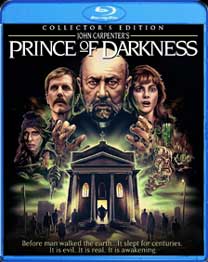 PRINCE
OF DARKNESS (1987) Blu-ray
PRINCE
OF DARKNESS (1987) Blu-rayDirector: John Carpenter
Scream Factory/Shout! Factory
 PRINCE
OF DARKNESS (1987) Blu-ray
PRINCE
OF DARKNESS (1987) Blu-ray“Before man walked the earth… it slept for centuries” and now John Carpenter’s PRINCE OF DARKNESS is awakening in high definition courtesy of Shout! Factory’s Scream Factory collector’s edition Blu-ray!

When the elderly priest caretaker of the long-derelict St. Godard’s church dies before his appointment with the bishop of the Los Angeles Diocese, Father Loomis (Donald Pleasance, HALLOWEEN) is appointed to investigate the secrecy around the church’s closure and continued maintenance. Loomis discovers among the priest’s possessions a key and a diary that connects the dead man to “The Brotherhood of Sleep” and discovers in a chamber beneath the church an eons-old canister which exerts a sinister influence on its surroundings. Loomis appeals to physics professor Birack (Victor Wong, BIG TROUBLE IN LITTLE CHINA) who recruits a university team of students from the physics department – including newly acquainted theoretical/applied duo Brian (Jamison Parker, TV’s SIMON & SIMON) and Catherine (Lisa Blount, NEEDFUL THINGS) – and microbiology to investigate the contents of the canister (which can only be opened from the inside). Also along are religious studies major Lisa (Ann Yen, LOVE OR MONEY) to translate the ancient tome which features a mix of Latin, Greek, Coptic, and quadratic equations two thousand years ahead of their invention. As night draws in, Lisa’s translation of the book suggests that canister holds the son of Satan who is fated to bring his father back from the dark side, Brian discovers that the fluid in the canister isn’t deteriorating but self-organizing (and is capable of telekinetic thought), the liquid takes possession of radiologist Susan (Anne Howard, THE WEATHERMAN) who proceeds to infect others in the group in a Cronenbergian fashion, and those who fall asleep share the recurring dream (“This is not a dream…”) about a dark figure emerging from the church and into the world. Meanwhile, ants, worms, and beetles start answering to a sinister higher power and the street people – lead by rocker Alice Cooper – turn murderous and seal the surviving members of the team inside the church (already filled with zombified team members) as the canister decides to open itself.
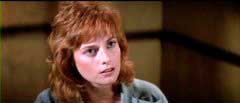 After
a string of big budget efforts like THE THING, CHRISTINE, STARMAN, and BIG TROUBLE
IN LITTLE CHINA, PRINCE OF DARKNESS marked John Carpenter’s return to
low-budget filmmaking – in a two-picture deal with Alive Films that included
THEY LIVE (Alive later recruited Wes Craven for the duo SHOCKER and THE PEOPLE
UNDER THE STAIRS), and it remains one of his most unnerving films. Dismissed
at the time of release, PRINCE OF DARKNESS has come to be recognized as a thinking
man’s horror film, with Carpenter – scripting under the name “Martin
Quatermass” – drawing from Nigel Kneale’s QUATERMASS &
THE PIT as much as H.P. Lovecraft – and, as Carpenter reveals in his interview
Gregory Benford’s novel “Timescape” – and Jean Cocteau’s
ORPHEUS (while namedropping authors Dennis Etchinson and John Wyndham as character
names, and Nigel Kneale as the university Brian has transferred from). The film
does suffer from having too many characters – although they are easier
to keep track of than the all-male cast of THE THING – and a cross-cutting
ending whose editing doesn’t quite match the intensity of the sequence
(and has the viewer wondering exactly what certain character absent from the
sequence are doing the entire time, that is if you’re not still pondering
who the hell keeps all of those candles in the basement lit). Parts of the story
also seem to have been retooled in the editing. What appears to have originally
been a longer dialogue sequence between Pleasance and Wong in the latter character's
office set-up in the church has been split into three sequences including one
preceding the team's arrival at the church (with an establishing shot of a highrise
meant to suggest a different setting even though the set decoration is the same
and a cot can be seen in the background). Many of the film’s effects are
simple-but-effective, with upside-down cameras, reverse motion, mechanical effects
(including a gag appropriated from one of Alice Cooper’s stage acts),
and a few matte paintings by Jim Danforth (EQUINOX). The recurring dream sequence,
however, has ingrained itself into the heads of viewers as much as it does the
characters, and its final rendition is open to interpretation.
After
a string of big budget efforts like THE THING, CHRISTINE, STARMAN, and BIG TROUBLE
IN LITTLE CHINA, PRINCE OF DARKNESS marked John Carpenter’s return to
low-budget filmmaking – in a two-picture deal with Alive Films that included
THEY LIVE (Alive later recruited Wes Craven for the duo SHOCKER and THE PEOPLE
UNDER THE STAIRS), and it remains one of his most unnerving films. Dismissed
at the time of release, PRINCE OF DARKNESS has come to be recognized as a thinking
man’s horror film, with Carpenter – scripting under the name “Martin
Quatermass” – drawing from Nigel Kneale’s QUATERMASS &
THE PIT as much as H.P. Lovecraft – and, as Carpenter reveals in his interview
Gregory Benford’s novel “Timescape” – and Jean Cocteau’s
ORPHEUS (while namedropping authors Dennis Etchinson and John Wyndham as character
names, and Nigel Kneale as the university Brian has transferred from). The film
does suffer from having too many characters – although they are easier
to keep track of than the all-male cast of THE THING – and a cross-cutting
ending whose editing doesn’t quite match the intensity of the sequence
(and has the viewer wondering exactly what certain character absent from the
sequence are doing the entire time, that is if you’re not still pondering
who the hell keeps all of those candles in the basement lit). Parts of the story
also seem to have been retooled in the editing. What appears to have originally
been a longer dialogue sequence between Pleasance and Wong in the latter character's
office set-up in the church has been split into three sequences including one
preceding the team's arrival at the church (with an establishing shot of a highrise
meant to suggest a different setting even though the set decoration is the same
and a cot can be seen in the background). Many of the film’s effects are
simple-but-effective, with upside-down cameras, reverse motion, mechanical effects
(including a gag appropriated from one of Alice Cooper’s stage acts),
and a few matte paintings by Jim Danforth (EQUINOX). The recurring dream sequence,
however, has ingrained itself into the heads of viewers as much as it does the
characters, and its final rendition is open to interpretation.
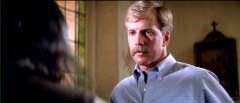
PRINCE OF DARKNESS was Carpenter’s first film with director of photography Gary B. Kibbe (Carpenter having parted ways with Dean Cundey on BIG TROUBLE IN LITTLE CHINA – on which Kibbe served as camera operator – while CHRISTINE and STARMAN were shot by Donald M. Morgan), and his compositions and lighting here harken back to Carpenter’s collaborations with Cundey than any of the films Kibbe subsequently shot for the director (up through VAMPIRES with the exception of the for-hire MEMOIRS OF AN INVISIBLE MAN). Carpenter’s throbbing score – composed in association with Alan Howarth – is at once monotonous and dynamic, carrying the viewer quickly through the film’s ten-and-a-half minute set-up – intercut with credits on black in the familiar font first utilized by Carpenter on THE THING’s opening titles – and establishing several of the film’s principle threads. The cast also includes Dennis Dun (BIG TROUBLE IN LITTLE CHINA), Peter Jason (IN THE MOUTH OF MADNESS), Dirk Blocker (POLTERGEIST), Jesse Lawrence Ferguson (NEON MANIACS), Thom Bray (THE HORROR SHOW), and Susan Blanchard (THEY LIVE). Casting director Joanna Merlin has a small but prominent role as a bag lady, and effects supervisor Robert Grasmere (THE RUNNING MAN) has a memorable bit as the skeptic who becomes an undead prophet (“I’ve got a message for you, and you’re not going to like it…”).
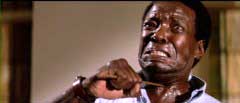 When
PRINCE OF DARKNESS first hit VHS stateside courtesy of Universal, its Panavision
compositions were brutally panned-and-scanned. Japan, however, got a letterboxed
laserdisc release that was a bit greenish and semi-cropped but still the preferable
alternative. While John Carpenter’s oeuvre fortunately was targeted in
the nineties for widescreen release on laser (and some on tape) stateside, PRINCE
OF DARKNESS was not among those titles; however it became one of the earliest
Carpenter films on DVD when Image Entertainment sublicensed several Universal
Pictures titles for release in the burgeoning format. Unlike some of their other
Universal acquisitions (as well as Goodtimes’ contemporaneous acquisitions
of HALLOWEEN II and HALLOWEEN III as well as some other Universal horrors) as
well as Universal’s own signature disc of THE THING, Image’s PRINCE
OF DARKNESS was released in an anamorphic widescreen transfer. Although a massive
improvement on everything released before it, Image’s fifteen year old
transfer doesn’t look as strong as it once did, with somewhat boosted
contrast and clipped highlights (looking a bit more like a well-preserved theatrical
print than a negative or intermediate-sourced transfer).
When
PRINCE OF DARKNESS first hit VHS stateside courtesy of Universal, its Panavision
compositions were brutally panned-and-scanned. Japan, however, got a letterboxed
laserdisc release that was a bit greenish and semi-cropped but still the preferable
alternative. While John Carpenter’s oeuvre fortunately was targeted in
the nineties for widescreen release on laser (and some on tape) stateside, PRINCE
OF DARKNESS was not among those titles; however it became one of the earliest
Carpenter films on DVD when Image Entertainment sublicensed several Universal
Pictures titles for release in the burgeoning format. Unlike some of their other
Universal acquisitions (as well as Goodtimes’ contemporaneous acquisitions
of HALLOWEEN II and HALLOWEEN III as well as some other Universal horrors) as
well as Universal’s own signature disc of THE THING, Image’s PRINCE
OF DARKNESS was released in an anamorphic widescreen transfer. Although a massive
improvement on everything released before it, Image’s fifteen year old
transfer doesn’t look as strong as it once did, with somewhat boosted
contrast and clipped highlights (looking a bit more like a well-preserved theatrical
print than a negative or intermediate-sourced transfer).
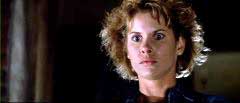
Universal issued their own edition in 2003 (with rather horrid artwork) in a different transfer. Framed at exactly 2.35:1, the dual-layer Universal disc did clip off some extraneous slivers of information on the left and right compared to Image’s 2.47:1 transfer (which might also have been minutely stretched, making the bowing of straight lines in wide-angle shots using older Panavision lenses more pronounced, although it is apparent even in newer transfers), but featured better contrast and a slightly sharper image; on the other hand, the DVD featured cadence breaks which caused sections of the progressive encoding to display the fields in the wrong order. This might have been a problem with Universal’s master since they went back to the Image transfer for their two-disc JOHN CARPENTER: MASTER OF FEAR set which paired the film with an anamorphic transfer of THE THING (while THEY LIVE shared a disc with VILLAGE OF THE DAMNED). All of these releases were barebones – apart from the theatrical trailer on the Universal stand-alone disc. Overseas owners Studio Canal, however, were distributing an edition in several European territories with an audio commentary (see below); and their own French release was a special edition with the commentary, introduction and scene analysis by Carpenter, an eighty-two page booklet (in French only) and 5.1 tracks in English and French (along with the original English 2.0 surround and French 2.0 mono dub).
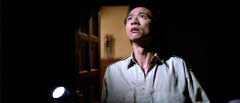 The
framing and contrast are in keeping with the Universal DVD transfer, but Scream
Factory’s 1080p24 MPEG-4 AVC-encoded 2.35:1 widescreen disc appears to
be a new transfer, and – as a fan of the film – it is like re-experiencing
the film for the first time. Not only are fine detail and textures more pronounced
here, as is the heft of the film’s not always necessary, but rhythmic
camera movements (including some shots photographed with the heavier pre-Steadicam
Panaglide rig which might have been more affordable for the lower budget production),
and a sense of environment (the fountain where Loomis confers with the cardinals
is revealed to be across the street from the San Fernando Mission but I never
noticed before that you can actually see that in a panning shot in the film,
and some of the reverse angles from church exterior reveal the area of downtown
Los Angeles to be not quite so derelict as they are meant to be). Also more
apparent are several of the more minute focus shifts between the foreground
and background, as well as a boom shadow never apparent before (and the woodwork
of Daniel Lomino’s sets unfortunately does a tad cheap in shots that linger
long enough to look). Audio is available in a 2.0 DTS-HD Master Audio rendering
of the original Ultra*Stereo mix – as well as a 5.1 upmix – in which
one can hear the beeping of computers underneath both the dialogue and Carpenter’s
almost non-stop score, and the clank of the basement chamber’s door opening
can actually be felt (it’s also more apparent that the sound of the door
opening and closing is one of the mysterious sounds that unnerves Lisa and the
others while they are alone. The disc also contains optional English SDH subtitles
which are mostly accurate apart from one or two of Pleasance’s accented
utterings.
The
framing and contrast are in keeping with the Universal DVD transfer, but Scream
Factory’s 1080p24 MPEG-4 AVC-encoded 2.35:1 widescreen disc appears to
be a new transfer, and – as a fan of the film – it is like re-experiencing
the film for the first time. Not only are fine detail and textures more pronounced
here, as is the heft of the film’s not always necessary, but rhythmic
camera movements (including some shots photographed with the heavier pre-Steadicam
Panaglide rig which might have been more affordable for the lower budget production),
and a sense of environment (the fountain where Loomis confers with the cardinals
is revealed to be across the street from the San Fernando Mission but I never
noticed before that you can actually see that in a panning shot in the film,
and some of the reverse angles from church exterior reveal the area of downtown
Los Angeles to be not quite so derelict as they are meant to be). Also more
apparent are several of the more minute focus shifts between the foreground
and background, as well as a boom shadow never apparent before (and the woodwork
of Daniel Lomino’s sets unfortunately does a tad cheap in shots that linger
long enough to look). Audio is available in a 2.0 DTS-HD Master Audio rendering
of the original Ultra*Stereo mix – as well as a 5.1 upmix – in which
one can hear the beeping of computers underneath both the dialogue and Carpenter’s
almost non-stop score, and the clank of the basement chamber’s door opening
can actually be felt (it’s also more apparent that the sound of the door
opening and closing is one of the mysterious sounds that unnerves Lisa and the
others while they are alone. The disc also contains optional English SDH subtitles
which are mostly accurate apart from one or two of Pleasance’s accented
utterings.
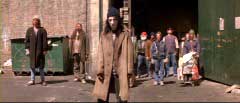
The film can also be viewed with an audio commentary featuring Carpenter and actor Peter Jason carried over from the import editions. It’s really more of an anecdotal track than an informational one, but a prepared moderator might have resulted in a more focused discussion rather than a more illuminating one. Jason asks Carpenter for some details of the backstory he is unprepared to answer (of the translations from the ancient book, he says he just tried to “write weird shit”), although Carpenter is more responsive to Jason’s questions about his methods of scoring (Howarth fills in the blanks in his own interview on the disc). Jason recalls how fun the glum-looking Pleasance was on set – along with his reticence to drive in Los Angeles – and working with Victor Wong and Alice Cooper. Carpenter also mentions doing some reshoots for additional violence (Thom Bray’s death with the bicycle frame, which was adapted from Alice Cooper’s microphone stage gag). Carpenter reveals that the mercury for the mirror effects (the close-ups only) was actually drained out of one of the crew’s Chapman cranes and replaced without incident.
 Courtesy
of Shout and Red Shirt Pictures are a quartet of new interviews. In "Sympathy
for the Devil" (10:27), Carpenter states that he isn’t looking forward
to the end of the world, but that apocalyptic movies are fun to make. Tired
of big-budget studio work, he developed PRINCE OF DARKNESS as a low-budget film
over which he would have complete control. He discusses how reading a book on
quantum mechanics inspired the story – as well as some other borrowings
mentioned above – and shows his film school background in comparing his
approach in the film to German Expressionism, in so far as the film –
for him – lingers on the content of the shot rather than Russian Montage’s
quick cutting to create excitement (although the same could be said for his
HALLOWEEN, and that his storytelling did become problematic from THE FOG onwards
with its emphasis on the mechanics of narrative in plots not sufficiently developed
or requiring a degree of ambiguity that did not gel with the “hit the
beats” approach). Carpenter also discusses how home video has given his
films a second life, particularly PRINCE OF DARKNESS which was not well-received
theatrically but developed its following on video.
Courtesy
of Shout and Red Shirt Pictures are a quartet of new interviews. In "Sympathy
for the Devil" (10:27), Carpenter states that he isn’t looking forward
to the end of the world, but that apocalyptic movies are fun to make. Tired
of big-budget studio work, he developed PRINCE OF DARKNESS as a low-budget film
over which he would have complete control. He discusses how reading a book on
quantum mechanics inspired the story – as well as some other borrowings
mentioned above – and shows his film school background in comparing his
approach in the film to German Expressionism, in so far as the film –
for him – lingers on the content of the shot rather than Russian Montage’s
quick cutting to create excitement (although the same could be said for his
HALLOWEEN, and that his storytelling did become problematic from THE FOG onwards
with its emphasis on the mechanics of narrative in plots not sufficiently developed
or requiring a degree of ambiguity that did not gel with the “hit the
beats” approach). Carpenter also discusses how home video has given his
films a second life, particularly PRINCE OF DARKNESS which was not well-received
theatrically but developed its following on video.
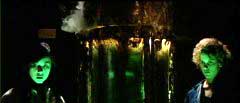
"Alice at the Apocalypse" (9:26) is of course an interview with rocker/actor Alice Cooper (please Shout! Factory, acquire MONSTER DOG from MGM so we can get a Cooper commentary) talks about growing up watching black and white horror movies, meeting John Carpenter (who he knew not only as a filmmaker but as a composer) and asking to be allowed to stop by and watch Carpenter filming PRINCE OF DARKNESS (the mirror scene) since Alive Films’ Shep Gordon was also Cooper’s manager. Carpenter first asked him to be an extra among the street people, and then their leader after seeing the rushes of the first bits he filmed. As previously covered in the Carpenter/Jason commentary, Cooper’s bicycle impalement gag is a riff on the microphone-stand impalement gag he does in his musical performances utilizing the same equipment.
 Actor
and special visual effects supervisor Robert Grasmere is "The Messenger"
(12:40) is on hand for an on-camera interview in which he delineates which effects
he was responsible for – special effects, not visual effects, as well
as the 24-frame video playback – and his delight at being asked cast in
the film (since that required negotiating with SAG). He discusses the trials
of working with the Plexiglas canister which was 1500 pounds and constantly
broke down, spraying green liquid everywhere. He also discusses his two death
scenes and working with the beetles (he still has his prosthetic head and teeth
applications), and how one of his lines became part of one of Universal’s
national ad campaigns for the film. On "Hell on Earth" (10:14) features
input from co-composer Alan Howarth on the score and his collaboration with
Carpenter. Labeling himself as more of an engineer, providing the sound palette
for Carpenter and building on top of his themes rather than expanding on them,
Howarth was also responsible for producer, editing, synchronizing, and recording
the scores (all in analog at the time).
Actor
and special visual effects supervisor Robert Grasmere is "The Messenger"
(12:40) is on hand for an on-camera interview in which he delineates which effects
he was responsible for – special effects, not visual effects, as well
as the 24-frame video playback – and his delight at being asked cast in
the film (since that required negotiating with SAG). He discusses the trials
of working with the Plexiglas canister which was 1500 pounds and constantly
broke down, spraying green liquid everywhere. He also discusses his two death
scenes and working with the beetles (he still has his prosthetic head and teeth
applications), and how one of his lines became part of one of Universal’s
national ad campaigns for the film. On "Hell on Earth" (10:14) features
input from co-composer Alan Howarth on the score and his collaboration with
Carpenter. Labeling himself as more of an engineer, providing the sound palette
for Carpenter and building on top of his themes rather than expanding on them,
Howarth was also responsible for producer, editing, synchronizing, and recording
the scores (all in analog at the time).
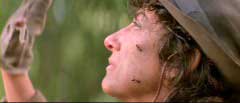
Universal’s TV versions of their eighties horror titles usually featured alterations not only for content – sometimes including the addition of deleted scenes to compensate the reduced running time – but their television cut of PRINCE OF DARKNESS radically altered the structure of the film to make it appear as if the events are Brian’s nightmare. The opening credits unfold rather quickly instead of over a twelve minute span, bracketed by Birack’s lecture – divided into two separate sessions – and Brian siting Catherine on campus. The TV broadcast Brian watches of the supernova is then followed by a story about the ancient tome being found in an inventory of the estate of Howard Hughes (utilizing close-ups of hands paging through the book from later in the film). This is followed by Brian going to sleep with passages from the news story echoing in his mind as the screen goes wavy and the dream starts. While Scream Factory was able to supply the entirety of the Universal TV cut of HALLOWEEN II because it was apparently misfiled, the TV cut of PRINCE OF DARKNESS may have been destroyed in the recent Universal Studios fire since what we have on offer here as the “Alternate Opening for the TV Version” (6:54) looks like a recent recording of a TV broadcast going by the TV14 rating (V for violence) in the upper left corner and a blurred out station logo in the lower right. There are a couple other differences between the theatrical and TV cuts, but it has been a while since I’ve seen it. Nevertheless, it’s a thoughtful extra.
In "Horror's Hallowed Grounds" (13:43), host Sean Clark visits the film’s locations, including the Japanese Union Church (now the David Henry Hwang Theater), the San Fernando Mission, and University of Southern California and discusses how the locations have changed since then. The featurette’s credits appear on black intercut with the opening sequence like the feature, and Clark reenacts the film’s ending. Promotional extras include the usual theatrical trailer grouped together with two radio spots (2:47) and a stills gallery. The cover is reversible with the original, more effective poster art on the inside, and the first pressings come with a slipcase featuring the new artwork. An Easter Egg (look for the cross in the popup menus) features a director’s Q&A from the 2012 Screamfest 25th anniversary screening of the film. (Eric Cotenas)